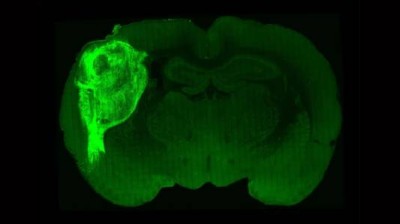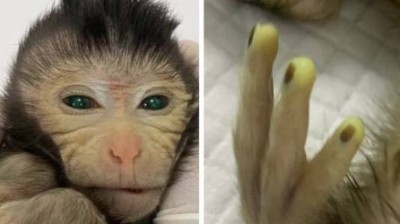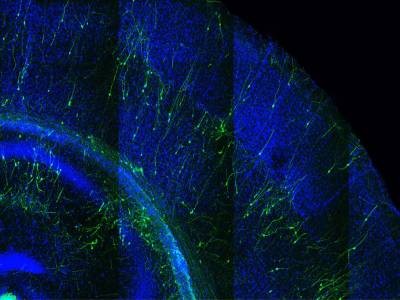[ad_1]
Two research teams have demonstrated that adding rat neurons to mouse brains that were missing crucial cells could help the organs to recover function1,2. The experiments could help scientists to better understand how different species’ brains develop, and even aid efforts to grow ‘chimeric’ pigs with human organs that could be used for transplantation in people.
Researchers have successfully generated hybrid, or chimeric, animals in the past. Among these have been mice with rat organs, including pancreases3, and mice with human neurons in their brains4. But no one had shown clearly whether rat neurons could be incorporated fully into a mouse’s brain circuits in such a way that they would become an essential part of controlling the host animal’s behaviour.
How neurons connect with one another, and fire, makes integrating cells from two species complicated, says Kristin Baldwin, a neuroscientist at Columbia University in New York City. “Neurons are not just Legos,” she says.
Early integration
In a paper published by one of the teams on 25 April in Cell1, Baldwin, molecular biologist Jun Wu at the University of Texas Southwestern Medical Center in Dallas and their colleagues attempted to test this by mixing rat and mouse neuronal cells very early in the mice’s development.
Human brain cells implanted in rats prompt excitement — and concern
First, they engineered the genes in a group of mice in a way that destroyed some neurons in the animals’ olfactory systems. This disrupted the circuits linking olfactory neurons in the nose with higher brain regions, leaving the mice unable to use their sense of smell to find mini-cookies that the researchers had buried in various places throughout the animals’ cages.
But when the researchers injected rat stem cells into blastocysts — early-stage embryos — of mice engineered in this way, the cells filled the gaps in the brain circuits. And once the mice had grown into adults, they were able to find their cookies by smell. Killing the mouse neurons created “niches” for the rat cells to take up residence in various places inside the animals’ olfactory circuits, as well as elsewhere in their bodies, Baldwin says. Her group is now working on methods for replacing specific mouse neurons with rat cells in a more targeted way.
In a Cell paper published by the second team, also on 25 April2, Wu and his colleagues developed a more aggressive strategy for getting rat cells into a mouse’s brain. Using C-CRISPR, a genetic-editing tool that cuts genes in multiple places to ensure that they are fully inactivated, the researchers wiped out every trace of a gene called Hesx1 in a group of mouse blastocysts. This gene controls the development of the forebrain: a large region in the brain that coordinates much of an animal’s behaviour.
This hybrid baby monkey is made of cells from two embryos
When the researchers allowed these blastocysts to develop into mice without forebrains, the animals died shortly after birth. But when Wu and his team injected rat stem cells into the blastocysts, the forebrains that developed were made entirely of rat cells. Once the mice had grown, they were healthy and seemed to act normally, although Wu says it would be difficult to determine whether there were any subtle behavioural differences between them and normal mice.
Hiro Nakauchi, a stem cell biologist at Stanford University in California, agrees that it would be hard to establish this. Researchers in his laboratory once tried making mice ‘smarter’ by giving them rat brain cells, but they abandoned the effort when they realized that the differences between rodents with and without the cells were too minor to detect statistically without testing the behaviours of a large number of hybrid animals. Still, Nakauchi says that the new papers are meticulous analyses of chimeric animals’ brains — something he is excited about. “This is what I have been awaiting,” he says.
‘Fascinating biology’
Wu and Baldwin say that their research addresses some long-standing concerns about developing chimaeras, particularly for the purpose of transplanting tissue or organs from animals such as pigs into people. Aside from ethical considerations, there is the concern that the human body will reject a transplanted chimeric organ. But because the teams added the rat cells so early in the mice’s development — long before the embryos had formed an immune system — the animals’ bodies never learnt to recognize the cells as foreign and never attacked them.
Hybrid brains: the ethics of transplanting human neurons into animals
Another concern is a mismatch in the developmental rates of species. However, the teams found that the mouse brains developed at the same rate as they would normally, rather than at the slower pace at which a rat usually develops.
“There’s lots of fascinating biology to be learnt from this [rat–mouse] chimaera,” says Jian Feng, a physiologist at the University of Buffalo in New York. He’s not surprised that the rat cells followed the pace of the mouse’s developmental ‘clock’. In 2020, his group published a paper about a mouse embryo that it had engineered to contain up to 4% human cells5. The embryo began developing human red blood cells 17 days into gestation — much earlier than these cells develop in human embryos — suggesting that human cells, too, could follow the molecular directions of their host.
Wu says that his laboratory now plans to use the technology developed for these studies to make chimaeras by transplanting cells from wild rodent species into lab mice. It’s difficult to study wild rodents, because they are hard to maintain and breed in captivity, he says. But making stem cells from their tissue samples and inserting them into mouse blastocysts might allow researchers to study how these other species’ brains develop and function.
[ad_2]
Source Article Link




